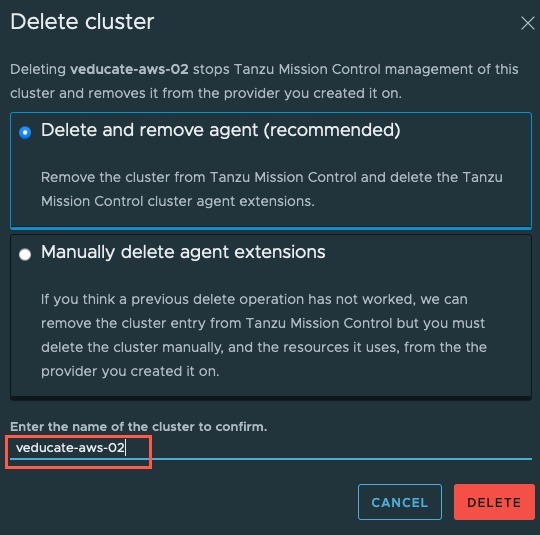In this blog post we are going to cover off how to delete a Tanzu Kubernetes Grid cluster that has been provisioned by Tanzu Mission Control. We will cover the following areas:
Below are the other blog posts in the series.
Tanzu Mission Control - Getting Started Tanzu Mission Control - Cluster Inspections - Workspaces and Policies - Data Protection - Deploying TKG clusters to AWS - Upgrading a provisioned cluster - Delete a provisioned cluster - TKG Management support and provisioning new clusters - TMC REST API - Postman Collection - Using custom policies to ensure Kasten protects a deployed application
We are going to use the cluster I created in my last blog post.
Below are my EC2 instances that make up my TMC provisioned cluster, here I have filtered my view using the field “tmc.cloud.vmware.com/cluster” + cluster name.
Deleting a Provisioned cluster in the TMC UI
In the TMC UI, going to the clusters view, you can click the three dots next to the cluster you want to remove and select delete.
Alternatively, within the cluster object view, click actions then delete.
Both options will bring up the below confirmation dialog box.
You select one of the following options:
- Delete and remove agent (recommended)
- Remove from TMC and delete agent extensions
- Manually delete agent extensions
- A secondary option whereby a manual removal is needed if a cluster delete fails
Enter the name of the cluster you want to delete, to confirm the cluster deletion.
In the cluster object view, you will see the message “Your cluster is being deleted”.
On the Clusters view, you will see the status for the cluster change to “Deleting”.
Going back to the AWS console, we can see the instances are shut down, and then terminated.
Will deleting my my provisioned cluster remove the EBS volumes mapped to my Persistent Volumes?
Below is a view of my Persistent Volume in my TKG cluster in the terminal window, showing the mapping back to the Elastic Block Store Volume which is created by the In-tree provisioner for AWS.
When a cluster is deleted, the volumes are unlinked from the EC2 instances they are linked to, so their status becomes available, meaning they can be attached to another instance if needed.
Deleting a AWS provisioned TKG cluster does not remove the underlying storage objects used by the persistent volumes. This is because the objects are created within the cluster and not by TMC.
If you no longer need the volumes, you can manually remove them.
Wrap-up and Resources
In this walk-through we used Tanzu Mission Control to delete a provisioned Tanzu Kubernetes Grid cluster which was running in AWS. All the steps provided in this blog post can be replicated using the TMC CLI as well.
As a reminder, to take real advantage of TMC I recommend you read the follow posts:
Tanzu Mission Control - Getting Started Tanzu Mission Control - Cluster Inspections - Workspaces and Policies - Data Protection - Deploying TKG clusters to AWS - Upgrading a provisioned cluster - Delete a provisioned cluster - TKG Management support and provisioning new clusters - TMC REST API - Postman Collection - Using custom policies to ensure Kasten protects a deployed application
You can get hands on experience of Tanzu Mission Control yourself over on the VMware Hands-on-Lab website, which is always free!
Regards









